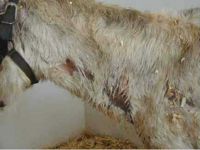Introduction

Donkeys are liable to dermatophyte (ringworm) infestation, but the clinical features are often less obvious than in horses. Ringworm due to Trichophyton and Microsporum dermatophytes are the most common fungal infection in most temperate climates.
Clinical signs
Donkeys present in the usual manner with centrifugally expanding roughly circular or coalescing patches of alopecia, scaling and mild exudation. There is seldom any significant pruritus, but the donkey may respond to gentle rubbing of the lesion with nose and mouth twitching suggesting some pleasurable relief. More extensive, less well defined areas may develop in cases affected with certain of the Trichophyton spp.
Diagnosis
Diagnosis is typically by hair pluckings from the active, outer margin of the lesion, or appropriately stained biopsies. Little is known of the range of dermatophytes affecting donkeys nor of any specific clinical features that might permit an informed guess as to the species involved in any particular case. Most cases are presented very late in the course of the disease and secondary bacterial infection, self-trauma and often ill-advised attempts at treatment can result in complicated multifactorial dermatitis.
Treatment
The large majority of dermatophytosis cases resolve spontaneously (as in horses), but there may be a delay if the donkey is either immunocompromised or is malnourished. Topical treatment with konazoles (such as enilconazole, miconazole) or natamycin washes will help to clear the infection and limit the environmental contamination with the highly resistant spores.
Oral griseofulvin should probably be avoided. It has no proven efficacy, it is expensive, it requires daily administration per os, and it has teratogenic properties for pregnant jennies.
Control
Environmental hygiene with individual tack, blankets and harnesses is a major aspect of the control of the disease. Spread to other donkeys must be prevented by good hygiene and isolation of affected cases. There are also important zoonotic aspects although most of the species identified in donkeys have a low zoonotic capability.
Immunity is reasonably effective and repeat infection with the same organism should not occur for over two years. Vaccine technology has not yet reached the donkey!
Literature Search
Use these links to find recent scientific publications via CAB Abstracts (log in required unless accessing from a subscribing organisation).
Dermatophytosis in donkeys related publications
References
- Knottenbelt, D. (2008) Skin disorders In Svendsen, E.D., Duncan, J. and Hadrill, D. (2008) The Professional Handbook of the Donkey, 4th edition, Whittet Books, Chapter 8
|
|
This section was sponsored and content provided by THE DONKEY SANCTUARY |
|---|
